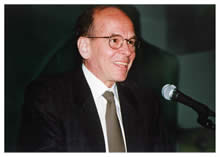 K. Barry Sharpless was born in 1941 in Philadelphia, Pennsylvania. He subsequently attended Dartmouth College where he was a pre-medical student majoring in chemistry. For three years he worked in the laboratory of Thomas A. Spencer, a new assistant professor of chemistry, who had just arrived at Dartmouth and who was instrumental in directing Sharpless to graduate school.
K. Barry Sharpless was born in 1941 in Philadelphia, Pennsylvania. He subsequently attended Dartmouth College where he was a pre-medical student majoring in chemistry. For three years he worked in the laboratory of Thomas A. Spencer, a new assistant professor of chemistry, who had just arrived at Dartmouth and who was instrumental in directing Sharpless to graduate school.
Sharpless graduated from Dartmouth College in 1963 and received his PhD with E.E. van Tamelen at Stanford University in 1968. He was a postdoctoral fellow with J.P. Collman at Stanford, and with Konrad Bloch at Harvard. He served on the faculties of MIT (1970-1977, 1980-1990), Stanford (1977-1980), and The Scripps Research Institute and its Skaggs Institute for Chemical Biology (1990-present).
Professor Sharpless has been called "the best process chemist in academics". He regards the oxidation of olefins as the single most
versatile, powerful and reliable class of transformations in organic
synthesis, so improving existing oxidative reactions and discovering new ones is a priority. He is best known for discovering general reactions for catalytic asymmetric epoxidation, dihydroxylation and aminohydroxylation, for which he received the Nobel Prize in 2001.
Current research focuses on click chemistry, his new synthetic strategem for the rapid discovery of chemical function. A copper-catalyzed fusion of azides and alkynes developed at Scripps is a near-universal best reaction for click chemistry functioning under essentially all conditions (even in living cells) and proving to be a route to highly diverse chemical products of all types, whether polyolefins, smart materials or drugs.
Professor Sharpless was elected a member of the National Academy of Sciences (1985) and an honorary member of the Royal Society of Chemistry (1998), and received numerous awards including the Prelog Medal from the ETH, Switzerland (1988), the Arthur C. Cope Award (1992), the Tetrahedron Prize (1993), the Roger Adams Award in Organic Chemistry (1997), the Centenary Lectureship Medal of the Royal Society of Chemistry (1993), the Chemical Sciences Award of the National Academy of Sciences (2000), and the 2001 Nobel Prize in Chemistry.
Photo by Jason S. Bardi/TSRI ©2001,The Scripps Research Institute. All Rights Reserved.